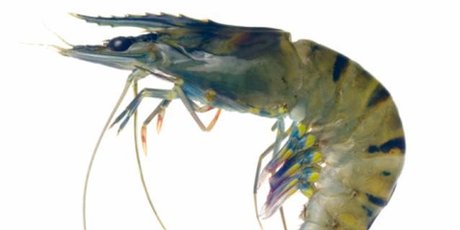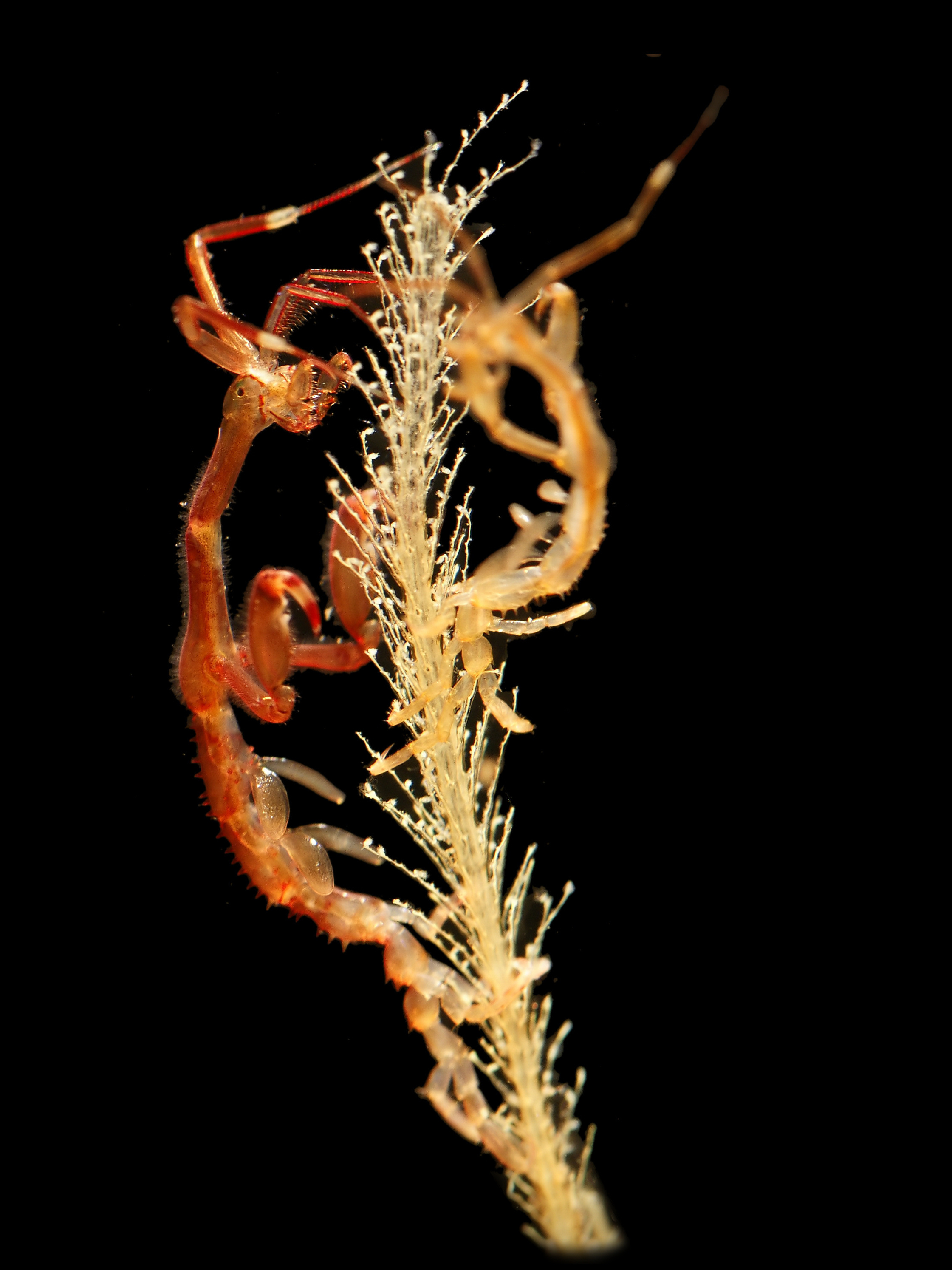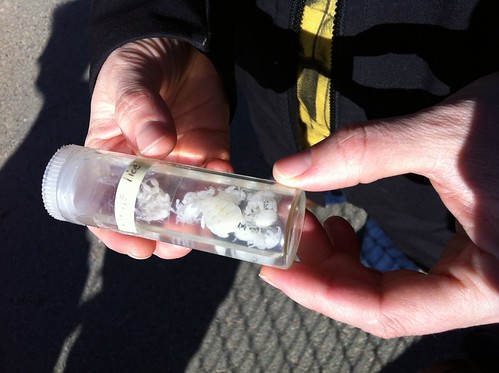Wednesday, February 29, 2012
A talk
It's going to be at 12 noon, Friday in the Benham Seminar Room (2nd floor of the "new" part of the Zoology building) . If you are around campus and have nothing to do over your lunch break you are most welcome to come along.
Of course, the slides aren't the talk...
Labels: my research, sci-blogs
Sunday, February 26, 2012
Sunday Spinelessness - They're alive!
It would take the most dedicated reader of The Atavism to remember the empty snail shell I wrote about last year. I'll admit even I'd mainly forgotten about myself, but this weekend I went on a little mini-field trip to collect a few samples for a colleague's ongoing project. In planning that trip I did remember the slightly mysterious shells I found last winter, and so decided to head back and see if I could get a few more to send along an an expert who might be able to put a name to them.
Sure enough, I found plenty more empty shells in different states of aging , but deep within the leaf litter I also uncovered one shell that was still playing house to an animal. I couldn't quite be sure there was a healthy animal in the shell when I first picked it up, since the snail was already retracted inside. Thhe easiest way to encourage a sleeping snail out from its shell is to warm in up, so I clasped it in my palm for about a minute and, well, here's the result:
Obviously, having taken the photographs I put this snail back under the nice moist leaf litter from which I'd taken it. Since then I've done a bit of research and I'm fairly confident that I've now identified this population down to genus level. But I've wrong about these things before (most recently by en entire superfamily...) so I'm still going to send the empty shells I collected from the same site to someone who has much more expertise than I do. I'll keep you updated on just exactly what these creatures are.
Labels: Dunedin, environment and ecology, molluscs, native snails, photo, sci-blogs, snails, sunday spinelessness
Wednesday, February 22, 2012
The Tree of Diversification (or why the March of Progress is wrong)

The so called "march of progress" has been used to describe the origin of our species thousands upon thousands of times. But it never happened. Only a few of the species depicted are potential ancestors for humans and many of them were contemporaries to each other (as the original diagram makes clear) so can hardly be different steps along a single evolutionary path.

I think that when you look at it this way it becomes clear that if we want to understand how the organisms depicted in the most famous icon of evoluton came to be we need to focus not just on how changes occur in one lineage, but on how new lineage form and become capable of changing in their own directions. At the moment there are probably 10 million species on earth, and just how they got to be here is surely one of the biggest questions that biology asks us. Speciation and diversification ought to be central to the way we think about evolution.
Labels: evolution, Human evolution, phylogenetics, sci-blogs, science, science and society
Sunday, February 19, 2012
Sunday Spinlessness - Amphipods are not prawns (and it matters)
Sadly, the New Zealand Herald managed to take just a tiny bit of gloss of the story. They choose to call the creatures "prawns" and illustrated their story with this picture...


Am I being ridiculously pedantic to care about this error? Is my life really so easy that I have time to worry about taxonomic and nomenclatural details associated with reports in the Herald? In fact, there's more to this error than the name. The Herald's conflation of these two distantly related groups highlights the way we fail to comprehend the true diversity of life on earth. So here's my attemp to show what you miss when you call an amphipod a prawn.
The scale of biodiversity
Every cell in my body is the result of an unbroken-chain of cell division that stretches back 3.8 billion years. I find that an absolutely staggering fact, but I shouldn't feel too special. Really, I 'm just like every creature on earth - riding on the edge of one of the lineages that extends out from biology's big bang at the origin of life. Plenty of people have tried to illustrate the history of life, here's one more look, based on DNA sequences from living organisms:
Forget animals and plants as the "two kingdoms" of life. For most of the history of life every creature on earth was a single cell. Even today, most of the lineages that extend out from the biology's big bang are made entirely of singled-celled organisms. Because this tree is based on those species that scientists have sequenced the genomes of, it drastically over-represents animals, but even here all animals are represented by the little twig that descending from the black-labeled node.
Biodiversity is more or less fractal, if we zoom in on that node and look at the phylogeny of animals we get another tree with branches:

As I've said before, it's very difficult to resolve the relationships among the different lineages of animals. No matter how the branches relate to each other, it's clear there are a lot of different ways to be an animal, and that I'm never going to run out of subjects to write about for these Sunday posts. All the lions, tigers, bears, elephants, fish, fowl, lizards and frogs that make their way around the world with the aid of a backbone are part of the branch labeled Chordates above. The rest are invertebrates, and so fair game for me. But I'm meant to to be talking about amphipods, so let's skip a couple of steps and move into the arthropods (jointed-limbed creatures including insects) then down further into crustaceans and in particular the class Malacostraca - a group that includes crabs, lobsters, shrimps, wood lice and indeed amphipods and prawns:

So what is an amphipod?

Most marine amphipods look more or less like their land-lubber relatives. The super giants that showed up in the Kermadek Trench are presumably from the genus Alicella, which is related to, and more less a scaled-up version of, your typical scavenging amphipod. Other groups of amphipods have remained small, but radically reworked their ancestral body plan. The most striking example of such a reimagining are the elongated caprellids or "skeleton shrimp":

Caprella mutica. Photo is CC-BY-SA 3.0 from Hans Willewart

Cyamids are commonly called "whale lice", and indeed their flattened bodies are similar to those of their distant insect cousins:
All the trees here were made with iTOL, this first is their main tree drawn unrooted. The animal and Malacostraca trees are the NCBI taxonomy drawn to phylum and genus level respectively
Labels: amphipoda, crustacean, sci-blogs, sunday spinelessness, taxonomy
Sunday, February 12, 2012
Sunday Spinelessness - A fly in the bee garden
We planted a bee garden this year - Borage, Phacelia foxglove and a couple of other plants that are known to attract honey bees and and their bumbling cousins into the garden:
The "bee garden" has worked - there is hardly a moment during the day when there isn't at least one bee making it's way around the little patch of garden. I'll show you some photos of them soon, but today I wanted to share a much smaller creature. A tiny fly perched on the leaf of a chickweed (Stellaria):
I'm terrible with fly taxonomy (or flylogeny if you'd rather) - I like to think I can at least get most of the spiders and insects I encounter down to the family level (roughly equivalent to successfully identifying myself as a great ape). With the exception of a few groups - crane flies, robber flies and hover flies, I get nowhere with flies. And so it is with this one, all I can tell you is that it's small (~3mm) probably from group called Schizophora. And that I quite like this photo.
Labels: diptera, environment and ecology, photos, sci-blogs, sunday spinelessness
Sunday, February 5, 2012
Sunday Spinelessness - King of the castle
I don't know exactly what was going on here, though I've got my ideas. Whatever I saw, it involved a lot of wild antennae-shaking from the two beetles facing each other and apparently very little interest in proceedings from the base of the "short, blunt beetle-pyramid".
Labels: beetle, environment and ecology, photos, sci-blogs, sunday spinelessness
Thursday, February 2, 2012
Proceedings of the 44th Carnival of Evolution
Welcome to the 44th monthly meeting of the Society for the Blogging of Evolution. As you can see below, we had a large number of submissions this month and, in order to have only a single track of talks and get people to the banquet with sufficient energy to enjoy themselves, some submissions have been included in a poster session following the last of the talks. Submissions were grouped purely on their subject material, and a submission included in the poster-session shouldn't be viewed as inferior to any featured as a talk.
I hope you enjoy a day's worth of reading, and remind you that a host is still required for next month's meeting. Sign up with Bjørn (bjorn[at]bjornostman.com) if you are interesting in helping out.
Session 1. Symposium on the evolution of novelty
- 8:15
- John Wilkins (Evolving Thoughts) Notes on Novelty 8: Conclusion? Post evo-devo
- 8:30
- Anne Buchanan (The Mermaid's Tale) Spontaneous combustion! How life began, how life begins.... Part I.
- 8:45
- Arvind Pillai (Fins to Feet) Coming of the Amniotes
- 9:00
- Bradly Alicea (Synthetic Daisies) The Evolution and Neuromechanics of very-fast movements
- 9:15
- Duncan Wright (Self-Writing Mechanism) On the Origin of Anxiety
- 9:30
- Anne Buchanan (The Mermaid's Tale) That's disgusting! Make up your own Just-So story about the evolution of an emotion
- 9:45
- Carl Zimmer (The Loom) Resurrecting Evolution to Solve an 800-Million-Year-Old Puzzle.
Session 2. Evolutionary ecology and life history evolution
Session 3. Philosophy and evolution
- 12:30
- Joachim (Mousetrap) Scientific paradoxes: Quine's remedy + Priest's independent reason"
- 12:45
- Zen Faulkes (Neurodojo) Hidden potential, and the concept of syngeny.
- 1:00
- John Wilkins (Evolving Thoughts). The difference between population concepts and 'population thinking'
- 1:15
- Adam M. Goldstein (The Shifting Balance of Factors) Ontology Talk at New York Botanical Garden
- 1:30
- Adam M. Goldstein (The Shifting Balance of Factors) Natural selection for near-death experience
Session 4a. Experimental Evolution
- 2:00
- S. E. Gould (Lab Rat @ Scientific American) Discrete steps to antibiotic resistance.
- 2:15
- Ford Denison (This week in Evolution) Experimental evolution of multicellularity: the movies
- 2:30
- Hird (Nothing in biology makes sense!) "Let's stay together” - Al Green
Session 4b. Timing and tempo of evolution
- 2:45
- Jeremy Yoder (Denim and Tweed) Baby steps versus long jumps: The "size" of evolutionary change, and why it matters.
- 3:00
- Martin Turcott(Eco-Evo Evo-Eco) Why should we care about rapid evolution?
- 3:15
- Paul McBride (Still Monkeys). Cornelius Hunter and the molecular clock.
- 3:30
- Zen Faulkes (Neurodojo) Once more into the cave
- 3:45
- Bjørn Østman (Pleiotropy) What determines rates of ecological speciation.
Session 5. Outreach and anti-creationism
- 4:15
- Rosangela Canino-Koning (Beacon) Professional Scientist, Amateur Ambassador .
- 4:30
- Supriya Khedkar (Grey Matter Updates) ..... , ,,,,, ;: ::::: !
- 4:45
- The Lorax (Angry By Choice). Creation thinking impedes understanding.
- 5:00
- Bjørn Østman (Pleiotropy) Behe on Behe, and Behe on Evolution
Poster session
- 1
- Ryan Kitko (Cunabulum) The peculiar modification of the locket trigger plants.
- 2
- Susan Elvidge (Genome engineering) Extinct isn't always extinct - the giant tortoise still lives
- 3
- Noah Matton (Nothing in biology makes sense!). Mass Extinctions: Did ancient humans get the party started 30,000 years ago
- 4
- Zen Faulkes (Neurodojo) Males have bigger brains than females, if those males are sticklebacks from Iceland.
- 5
- Scott Lee (Scott Free Thinking) IGF-1 and Animal Protein? Does Eating Meat Cause Cancer?.
- 6
- Øystein Horgmo (The Sterile Eye) Blue Blood Donors of the Sea







